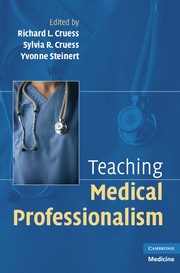Book contents
- Frontmatter
- Contents
- List of Contributors
- Foreword by William M. Sullivan
- Introduction
- PART ONE WHAT IS TO BE TAUGHT
- PART TWO THEORY
- PART THREE PRINCIPLES
- PART FOUR PRACTICE: CASE STUDIES IN TEACHING PROFESSIONALISM ACROSS THE CONTINUUM
- 12 Teaching Professionalism in a Traditional or Organ-Based Curriculum
- 13 Learning Professionalism in a Problem-Based Curriculum
- 14 Teaching Professionalism and Fostering Professional Values during Residency: The McGill Experience
- 15 Continuing Professional Development: A Focus on Professionalism
- APPENDIX A Definitions of Professionalism
- APPENDIX B Core Attributes of Professionalism
- APPENDIX C The Teaching of Professionalism: Vignettes for Discussion
- APPENDIX D A Matrix for “Matching” Teaching Methods to Attributes
- APPENDIX E Sample Grid for Use with Discussion of Vignettes
- APPENDIX F Sample Questions to Guide Discussion about the Social Contract: Small-Group Leaders' Guide with Suggested Responses
- APPENDIX G Professionalism Program for Residents: Suggested Outline for Small Group Facilitators
- APPENDIX H Sample Evaluation Form for Residents' Half-Day Program on Professionalism
- Index
- References
15 - Continuing Professional Development: A Focus on Professionalism
Published online by Cambridge University Press: 01 September 2009
- Frontmatter
- Contents
- List of Contributors
- Foreword by William M. Sullivan
- Introduction
- PART ONE WHAT IS TO BE TAUGHT
- PART TWO THEORY
- PART THREE PRINCIPLES
- PART FOUR PRACTICE: CASE STUDIES IN TEACHING PROFESSIONALISM ACROSS THE CONTINUUM
- 12 Teaching Professionalism in a Traditional or Organ-Based Curriculum
- 13 Learning Professionalism in a Problem-Based Curriculum
- 14 Teaching Professionalism and Fostering Professional Values during Residency: The McGill Experience
- 15 Continuing Professional Development: A Focus on Professionalism
- APPENDIX A Definitions of Professionalism
- APPENDIX B Core Attributes of Professionalism
- APPENDIX C The Teaching of Professionalism: Vignettes for Discussion
- APPENDIX D A Matrix for “Matching” Teaching Methods to Attributes
- APPENDIX E Sample Grid for Use with Discussion of Vignettes
- APPENDIX F Sample Questions to Guide Discussion about the Social Contract: Small-Group Leaders' Guide with Suggested Responses
- APPENDIX G Professionalism Program for Residents: Suggested Outline for Small Group Facilitators
- APPENDIX H Sample Evaluation Form for Residents' Half-Day Program on Professionalism
- Index
- References
Summary
INTRODUCTION
The Case for Continuing Professional Development in Professionalism
There are many “gaps” in clinical practice. The Institute of Medicine reports, and those from the Rand Corporation, provide a clear picture of the clinical practice gap: the failure to meet best evidence performance at the time of care. This phenomenon is complex and multicausal, the product of incomplete information, poor information transfer to and retention by the practitioner, poor patient compliance and understanding, and a host of other environmental or setting-specific issues.
This is not the only care gap however: gaps also exist in clinician conduct between what we would normally call professional behavior and those that occur in the real word of clinical practice. These gaps occur when physicians and others fail to follow the tenets of the “Charter on Medical Professionalism,” that is, demonstrate adherence to the principles of the primacy of patient welfare, patient autonomy, and social justice. These two elements, elsewhere described as the science and the art of medicine, contribute to patient's frustrations with health care systems virtually world wide.
The following are examples of the latter problem. They may be illustrative; they are certainly familiar:
“Turfing”: this word denotes a patient transfer or triage from one physician to another when the care of that patient feels more troublesome than it is worth. A widespread phenomenon in medical training programs, turfing appears to allocate patient care to meet physicians' rather than patients' needs.
Commercial influence: many examples exist in which professional educational products and physicians' practices themselves, including clinical practice guidelines and publications, have been biased by the involvement of commercial influences such as those in the pharmaceutical industry.
[…]
- Type
- Chapter
- Information
- Teaching Medical Professionalism , pp. 263 - 278Publisher: Cambridge University PressPrint publication year: 2008

